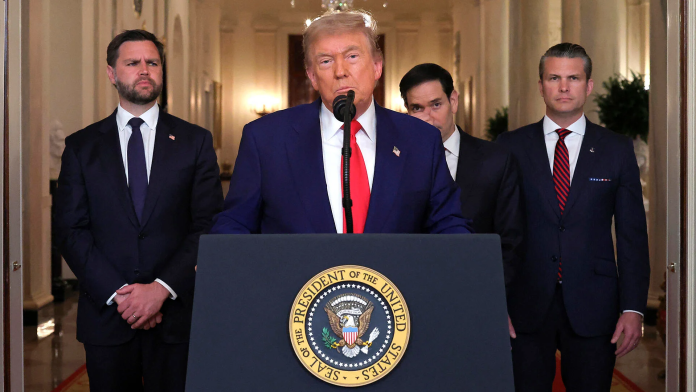US President Donald Trump announced targeted strikes against Iran’s Fordo, Natanz, and Esfahan nuclear facilities, prompting IAEA Director General Rafael Grossi to call an emergency meeting on 23 June.
In a national address flanked by Vice President JD Vance, Secretary of State Marco Rubio, and Defence Secretary Pete Hegseth, Trump stated:
The US military carried out massive precision strikes on the three key nuclear assemblies in the Iranian regime: Fordo, Natanz and Esfahan. Our objective was the destruction of Iran’s nuclear enrichment capacity and a stop to the nuclear threat posed by the world’s number one state sponsor of terror.
Regional alert and strategic shift
The operation marked a dramatic reversal of US disengagement from Middle Eastern conflicts, deploying B-2 stealth bombers that dropped 30,000-pound GBU-57 Massive Ordnance Penetrator bombs on Fordo.
Simultaneously, US Navy submarines fired Tomahawk cruise missiles at Natanz and Esfahan. A senior US official confirmed initial assessments indicated Fordo had been “taken off the table,” noting its mountain burial at 90 metres depth made conventional strikes impossible.
Over 40,000 US troops across Middle Eastern bases now brace for Iranian retaliation. Critical vulnerabilities include the Strait of Hormuz, where Iranian mining could threaten 25% of global oil shipments; and US bases in Bahrain, Qatar, and UAE within range of pre-positioned Iranian missiles.
Reinforcements include F-22, F-16, and F-35 squadrons rushed to regional airbases, supported by three dozen refueling tankers. The carrier USS Carl Vinson patrols the Arabian Sea, while USS Nimitz canceled a Vietnam port call to join the deployment.
IAEA’s grave nuclear safety warnings
IAEA Director General Rafael Mariano Grossi warned the Security Council of a “sharp degradation in nuclear safety” following the attacks. While confirming no off-site radiation release, he emphasised catastrophic risks at Bushehr Nuclear Power Plant:
A direct hit could result in a very high release of radioactivity to the environment. Similarly, a hit that disabled the only two lines supplying electrical power to the plant could cause its reactor’s core to melt.
Grossi confirmed significant damage at Natanz, where uranium isotope dispersion created internal contamination hazards, and at Esfahan’s uranium conversion plant. He stressed IAEA inspectors stand ready to verify Iran’s 400kg stockpile of 60%-enriched uranium “as soon as safety conditions allow,” urging restraint to avoid delaying diplomatic solutions.
Iran’s Foreign Minister Abbas Araghchi condemned the strikes as a “grave violation of the UN Charter,” reserving “all options to defend sovereignty.” US intelligence anticipates retaliatory actions ranging from cyberattacks to missile barrages or Hormuz mining, a scenario that would trigger global energy price spikes.
UN Secretary-General António Guterres warned of a “spiral of chaos,” whereas Russia’s UN Ambassador Vasily Nebenzya predicted “hitherto unseen nuclear catastrophe.” Domestically, Democratic leaders condemned Trump’s bypassing of congressional authorisation.
The strikes now test Trump’s warning that Iranian retaliation would face “force far greater than what was witnessed tonight.”
